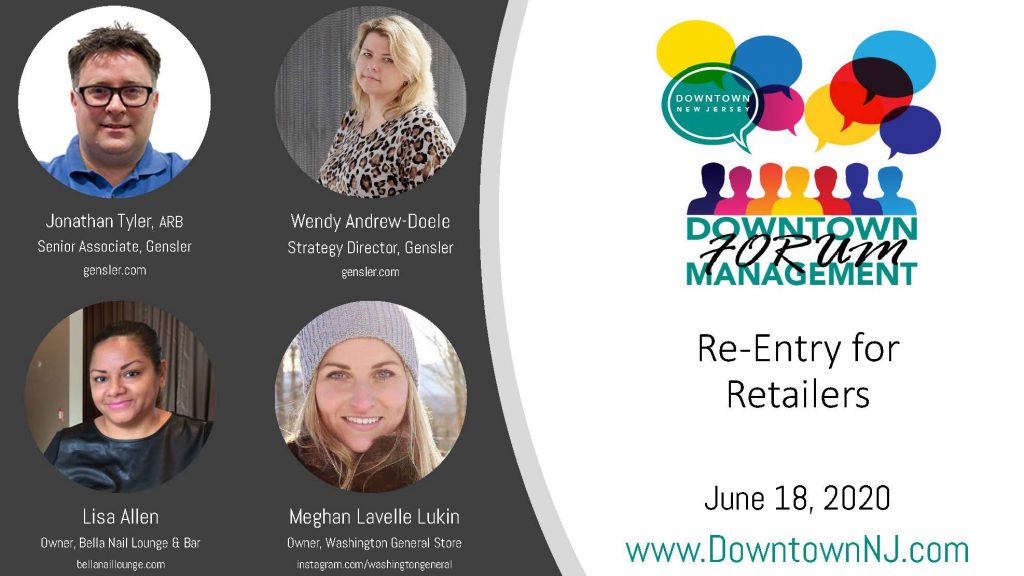Re-Entry for Retailers
Courtenay D. Mercer, PP, AICP
Executive Director, Downtown New Jersey
Rachael Thompson Panik
Associate Planner, Mercer Planning Associates
June 19, 2020
Downtown New Jersey is providing a series of virtual opportunities for downtown managers, economic development professionals, and public officials to exchange ideas about best practices related to downtown economic development in light of the COVID-19 crisis.
As our downtown retail establishments are permitted to reopen in the coming weeks, will need to employ design countermeasures to survive the short term and to thrive in the long term. At this forum, we learned best practices from industry experts, and how NJ business owners are handling the transition.
Panelists:
- Jonathan Tyler ARB, Senior Associate, Gensler
- Wendy Andrew-Doele, Strategy Director, Gensler
- Lisa Allen, Owner, Bella Nail Lounge & Bar
- Meghan Lavelle Lukin, Owner, Washington General Store
View Powerpoint>
To begin the discussion, Downtown New Jersey Executive Director, Courtenay Mercer, shared some statistics from the Governor’s Restart & Recovery Council to lay the framework of perceptions about re-opening and expectations for recovery. A recent McKinsey survey indicated that most New Jersey residents do not plan to resume normal activities even after the stay-at-home restrictions are lifted. While a vaccine and treatment for COVID were most important to consumers to resume to normal life, survey respondents also indicated that wearing masks outside of the home, and regular screening and testing at places of business and employment were of importance to regain confidence. Also, New Jersey residents place a heavier emphasis on promoting safety in the workplace than national respondents.According to the US Census Bureau’s most recent Small Business Pulse Survey, the number of small businesses in the state with a month or more of operating cash on hand has increased since May, which is likely attributed to the distribution of PPP and other relief funds. In addition, small businesses now believe that it will take longer for business to resume to normal levels than in previously anticipated. In early May, more than 50% of respondents thought operations would return to normal in less than 6 months, while only a third felt that way by early June.Returning to the Store
Jonathan Tyler, a retailer designer and practice lead at Gensler, shared insights into how retailers can prepare to open safely amidst ongoing concerns about COVIS-19. Retailers are being required to undertake fast-paced, iterative change in wholly unprecedented ways. Several months ago, Gensler released a presentation targeted at helping national retailers regain their footing in the wake of changing consumer preferences and national/state guidelines. This presentation has been adapted to focus on small businesses so that they can be safe and move forward in a sensible way.The most recent operation mandates applying to New Jersey retail include the following:- Limit occupancy to 50% of maximum store capacity at all times.
- Establish hours of operation specifically for the exclusive use of high-risk individuals.
- Install some kind of physical barrier between customers and cashiers, or any other place that shoppers and employees cannot maintain six feet distancing.
- Provide employees break times for hand washing.
- Arrange for contactless pay where possible, including pre-order and pickup and delivery where possible.
- Provide sanitizers for all customers and employees.
- Frequently sanitize high-touch areas.
- Make use of conspicuous signage at entrances to make sure that that customers are aware of social distancing requirements.
- Make out spaces for socially distant queuing.
- Require employees and customers to wear cloth face coverings, and require workers to wear gloves.
- Limit occupancy to 10% of maximum seating capacity.
- Ensure six feet of distance between all workers and customers.
- Follow the same guidance on sanitation, social distancing, contactless payments, signage, and PPE as retailers.
Back to the Office
Strategy Director at Gensler, Wendy Andrew-Doele, explains that there may be additional considerations for ensuring safety for employees (and their customers) in the office. It is important to first consider how people will be moving from outside to inside of the workspace and ensure that each step of that process is safe. Consider where people are parking or alighting from public transportation. Be sure that people know where to go if the business is channeling to a single entrance. Also, if the business is planning to screen people as they enter the building, make sure that there is adequate staff, resources, and space to do it at the scale needed. As people circulate through space, think of ways to create single direction traffic; taking advantage of front and back doors to allow people to move through the space in a more fluid motion than people entering and exiting in the same location. As people move deeper into the space, be mindful of shared environments, such as public restrooms, central meeting spaces, or other common spaces. In some cases, business may need to limit gathering in common spaces, as this increases likelihood of transmission of the virus through the air.Business, retail, and restaurant space must all be very cognizant of the tone of messaging and signage – it should be appropriate to the type of business. Alarming tones in messages can create a negative perception, while lighthearted messaging can be appropriate for some environments. Think carefully about how the tone of your messaging aligns with the business’ brand.In the workplace, you must think about how employees move about space as they are there for longer periods of time. Be mindful of unintentional roadblocks or possible collision spaces in the environment. These kinds of pinch points can create environments where people are unable to keep a safe distance away from other people, which may make employees and customers feel unsafe. For employees, be sure to separate workplaces from one another.Business Owner Perspective
Lisa Allen, owner of Bella Nail Lounge and Bar in Newark, has taken notable steps to make sure that her business is safe for customers and employees. Guidelines for salons and other personal care businesses came out last Friday. Per those guidelines, Bella Nail Lounge will provide services by appointment only. They have been using autoclaving to clean their instruments already, but now they are changing how they assign instruments to their technicians to make sure they are as sanitary as possible. They have also implemented additional cleaning procedures to their pedicure chairs, and they are limiting appointment slots for the chairs by 50% to ensure social distancing is possible. Lisa has spent significant time re-acclimating staff to the new procedures so that they are able to be leaders for their customers. In addition, they have gone to a completely cashless system to minimize contact. Lisa and her team decided not to open on the first day they were allowed, in order to ensure all safe is sufficiently trained and safety protocols are in place.Meghan Lavelle Lukin, owner of Washington General Store in Hoboken shared her experience as a storeowner. The store opened a week ago to in-person consumers, and they have seen customers begin to trickle back in. They opened up their space as much as possible given their space limitations and have pulled some merchandise from the floor to make more room for comfortable shopping. They limited capacity to 10 people in the store at a time. As mentioned by Gensler, Meghan has found that public cleaning has mattered immensely to customers. They are both cleaning the must public areas and providing customers with information about the other things they are doing to ensure cleanliness. As an additional safety measure, employee temperatures are taken at the beginning and end of each shift. They also invested in an electrostatic handheld sprayer to sanitize their product, which has helped save time and money by not needing them to sanitize each item by hand before it is placed on the floor for sale. Meghan has observed that customers are cautious while shopping, but that they seem excited to get out.In order to stay open when the store had to be physically closed to customers, the Washington General store began taking online orders. While they do not have an e-commerce site, they have taken advantage of their strong social media presence. They have increased the frequency and number of posts, highlighting products available for purchase. They allowed customers to place orders through email and pay via Venmo for curbside pickup or delivery. Meghan said customers felt like they had a personal shopper experience.Discussion and Q&A
- How much has it cost to do what you need to do to prepare for opening up? Megan spent about $1,000 in PPE, and Lisa said she spent about $1,000 as well. That includes face shields, masks for employees and customers, and investing in electrostatic sprayers. Lisa noted that the expense of lost business over the past three months is far more significant than the cost if adapting her space.
- How do you safely sanitize shared office equipment (microwaves, coffee makers, etc.)? Having Lysol wipes available, and cleaning all the time makes a huge difference. Some office clients are creating sanitation stations that make cleaning supplies readily available. Office should make use of paper towels and single use sanitation wipes where they can. That allows people to clean both the space and their hands. Also consider closing kitchens or fridges, if that will work with the business. For milk or cream for coffee, consider having a single staff member be responsible for dispersing those shared items, or consider eliminating shared resources altogether.
- Megan noted that 50% of business was online. Did you manage this in real-time? Previously, they had made use of an e-commerce site, but they shut it down due to low usage. Now, they are widely using Instagram, and they plan to continue using it going forward. Meghan said that she actually had her employees working more hours to handle the social media and online sales/delivery.
- Lisa, what did you do while the salon had to be closed to customers? They have been active on Instagram, even posting a lot of non-nail related posts in favor of more humorous things to help people cope with all that is going on in the world. In light of recent events and protests, the here has also been an increase in desire to support black businesses, which has allowed more opportunity to grow her platform and following.



